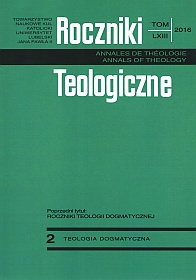The Subject of Creatio Continua and its Ecclesial Aspect
Abstract
It is God who is the subject of creatio continua; in Christianity it is a triune God. Fundamentally divine nature, Divine Persons: God the Father, God the Son and the Holy Spirit, who in the logic of the internal life of the Trinity is third and in relation to the world the most direct. The personal specificity of the Third Divine Person predestines it to activity, creativity, to stirring creative power and action in created beings. The Holy Spirit develops and unites, creates the interior of the beings, combines them and strengthens the link with the Creator.
This ongoing creation is encoded in the act of creation and is in keeping with the workings of Providence, which also is a creation of the Trinity, and indirectly a creation of people: individuals and societies.
Participation in the act of creation stands in proportion to the growth in holiness, which means it is proportional to becoming a person. Created beings personalize themselves through participation in creatio continua, and by participating in this act, they personalize themselves. All this is implemented though the activity of the intellect, will and emotions.
It is Jesus Christ in his capacity of God and man who occupies the centre stage of the ongoing creation.
References
Alvarez Gomez J., C.M.F., La permanente novedad de la vida consagrada en la Iglesia, „Confer” 4(1992).
Balthasar H.U. von, Trójca Święta a stworzenie, w: Kosmos i człowiek, red. L. Balter, K. Czulak, P. Góralczyk (Kolekcja Communio 4), Poznań−Warszawa 1989.
Bartnik Cz.S., Gromy mówiące. Kazania, przemówienia, publicystyka społeczno--polityczna, (Dzieła Zebrane, t. 5), Lublin 1999.
Bartnik Cz.S., Dogmatyka katolicka, t. 1, RW KUL, Lublin 2000.
Coda P., Pentecostés, w: X. Pikaza, N. Silanes (red.), Diccionario Teológico. El Dios cristiano, Salamanca 1992, s. 1061-1072.
Cruz Hernandez M., Historia del pensamiento en Al-Andalus (2). Historia, Biblioteca de la Cultura Andaluza, Editoriales Andaluzas Unidas, Sevilla 1985.
Fernandzez Ardanaz S., A la bùsqueda del paradigma original del hombre. Gen 1,26 y 2,7 en los pensadores cristianos del s. II, „Scriptorium Victoriense” 35(1988), nr 2, s. 30-113.
Fueyo J., La vuelta de los Buddas, Organización Sala Editorial S.A., Madrid 1973.
Gonzáles Montes A., Religion y nacionalismo, la doctrina luterana de los dos reinos como teología civil, Universidad Pontificia de Salamanca, Bibliotheca Salmantinensis, Estudios 51, Salamanca 1982.
Greshake G., Trójjedyny Bóg. Teologia trynitarna, przeł. bp J. Tyrawa, (Der Dreieine Gott. Eine trinitarische Theologie, Verlag Herder, Freiburg im Br. 2007 [wyd. 3; 1997 wyd. 1]), TUM, Wrocław 2009.
Kowalczyk M. SAC, Opatrzność Boża w ujęciu personalistycznym, „Communio” 6(2002), s. 117-129.
Laurentin A., Le Pneuma dans la Doctrine de Philon, ETL 27(1951), s. 390-437.
Lavaud L., Opatrzność otwarta na ryzyko wolności, „Communio” 6(2002), s. 104-116.
Liszka P., Teologia historii zbawienia, w: Ku mądrości teologii, red. K. Góźdź, E. Sienkiewicz, Szczecin 2008, s. 159-169.
Ochman J., Średniowieczna filozofia żydowska (Historia filozofii żydowskiej, t. 2), Universitas, Kraków 1995.
Reutt M., Przedmowa, w: M. Bierdiajew, Nowe średniowiecze (Berlin 1924), Komorów 1997, s. 5-11.
Schall J.V., TJ, O realności fantazji, w: Tolkien. Księga pamiątkowa. Studia o spuściźnie literackiej, red. J. Parce, (Tolkien: A celebration, HarperCollinsPublischers 1999), tł. J. Kokot, Zysk i S-ka, Poznań 2003, s. 72-77.
Siemieniewski A., Ścieżką nauki do Boga. Nauki przyrodnicze i duchowość w starożytności i w średniowieczu, Wrocław 2009.
Tolkien J.R.R., O baśniach, tł. J. Kokot, w: J.R.R. Tolkien, Potwory i krytycy i inne eseje, red. Ch. Tolkien, Zysk i S-ka Wydawnictwo, Poznań 2000.
Tourpe E., Duch, natura, pośredniczenie, w: Duch Odnowiciel (Kolekcja Communio 12), Pallotinum, Poznań 1998, s. 101-115.
Copyright (c) 2016 Roczniki Teologiczne

This work is licensed under a Creative Commons Attribution-NonCommercial-NoDerivatives 4.0 International License.





